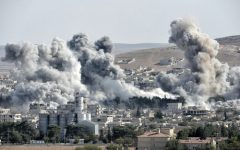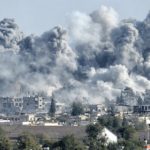Military Might in the Middle East: The Political Posturing of the Powerful

In little over a week, US president Donald Trump has carried out three acts of military aggression that appear to be targeting not only the countries directly involved, but also send a clear message to an alliance of nations that traditionally oppose the United States.
Trump rose to power on a campaign built on anti-war rhetoric and isolationist pledges. He warned that Hillary Clinton’s plans for Syria would “lead to world war three.” But now, the newly-inaugurated president has taken it upon himself to carry out an airstrike against the Assad regime.
Talk of a third world war often revolves around the US aligning with its long-standing allies, such as the United Kingdom, France and Australia, and opposing forces comprising an alliance between Russia, China and Iran.
Indeed, all the nations that the Trump administration has recently taken aim at are long-standing allies of this powerful opposing alliance.
The new administration takes aim
The devastation of the Syrian civil war continues. Over the weekend, a suicide bomber murdered 126 people – including 80 children. Those killed were part of an evacuation convoy fleeing the besieged towns of al-Foua and Kfraya.
The US fired 59 Tomahawk missiles at the government-controlled Shayrat airbase in Syria on April 7. Trump claimed the Syrian airstrike was in response to a deadly chemical attack on civilians that was allegedly carried out by the Assad government.
The attack in the town of Khan Sheikhun, in the rebel-held area of Idib, resulted in the deaths of 86 people, including at least 30 children.
Syria: an ally of the alliance
Russia has been a close ally of Syria for over half a century. This association is said to have been formed as a reaction to the CIA’s covert meddling in Syrian politics that began in 1949. Moscow has supported the Assad government in the civil war with military aid since 2011, and as of September 30 2015, Russia began direct military intervention in Syria.
Even though the US government warned Russia that US strikes were targeting the Syrian government, it may also be seen as an indirect show of strength aimed at Moscow.
Predictably, he Russian government denounced the strike, warning it could derail global stability. Russia also denied that the Assad government was behind the attack, claiming the chemical weapons had been released from rebel arsenal, and calling for an international probe into the incident.
Syria is also an important ally of Iran’s. In August last year, Tehran began allowing Russia to use an Iranian airbase to strike targets in Syria.
In the wake of the US airstrikes, Russian foreign minister Sergey Lavrov hosted his Iranian and Syrian counterparts in a meeting in Moscow. The minister declared the US attack was a blatant “act of aggression,” warning “the US and its allies” against further military action in Syria.
And it seems that Trump was also flexing his muscles at Beijing, when he told Chinese president Xi Jinping that he’d just launched the airstrike against Syria while the pair were eating dessert at his Mar-a-Lago estate in Florida. The US president ordered the military action right before sitting down for his meal.
Beijing has supported Moscow six times in vetoing UN proposals sponsored by the west to sanction the Syrian government since the start of the war.
And while China abstained from voting on a UN resolution condemning the chemical attack in Syria, China’s Foreign Ministry spokeswoman Hua Chunying said the country condemned the US airstrike.
The trouble in the Korean Peninsula
Several days after the airstrike in Syria, the Trump administration turned its attention towards one of China’s closest, and most troubled, allies, North Korea. The US ordered an aircraft carrier strike group to move towards the Korean peninsula, over concerns about North Korea’s missile program.
The rogue state has been testing missiles in the direction of the Sea of Japan over recent months. Pyongyang has also tested five nuclear devices since 2006, and is preparing for its next test. Trump has warned that the US is prepared to act alone in dealing with the nuclear threat that he believes North Korea poses.
While China has asked Russia to help solve the tensions diplomatically, some analysts believe that Washington’s manoeuvres are more about posturing in Beijing’s direction, rather than threatening supreme leader Kim Jong-un.
As veteran documentary filmmaker John Pilger has recently exposed, the US has succeeded in encircling China with 400 military bases over recent decades. And now rumours keep surfacing that China is sending an extra 150,000 troops to the border with North Korea.
The mother of all bombs
And at the end the week in an almost unfathomable show of warmongering, Trump dropped the largest non-nuclear weapon the US has ever used in combat on an Islamic State tunnel and cave complex in eastern Afghanistan.
An estimated 90 Islamic State militants were killed in the blast last Thursday, according to the Afghan government. And while US military actions in Afghanistan are nothing new – they carried out 400 airstrikes in February and March this year – the use of this gigantic bomb might also act as a threat to the country’s historical ally and neighbour, Iran.
Trump took aim at Iran during the first days of his presidency. He pledged to take a tough stance against the Islamic republic and threatened reprisals after Tehran carried out ballistic missiles tests in early February. At that time, there were also concerns amongst Iranian citizens that the US might actually bomb the country.
Iran and the United States have been at loggerheads since the 1979 Iranian revolution toppled the US-backed Shah. More recently, Washington has been accusing Tehran of trying to broaden its influence over Arab nations, such as Iraq, Syria and Yemen.
A joint bill was introduced before the US House of Representatives in January, which allows the president to launch a pre-emptive strike on Iran in order to stop the country developing nuclear weapons.
So who’s next?
Tensions continue to mount on the Korean Peninsula. Pyongyang attempted a ballistic missile test that failed over the weekend, as US vice president Mike Pence was making his way to South Korea on a diplomatic visit. And there’s even been talk of the US making a pre-emptive strike on North Korea.
So it seems that after three months in office, the Trump administration is becoming accustomed to using the vast arsenal of weaponry it has at its disposal. But, it’s yet to be seen which nation the US will take aim at next, and what impact this might have on the nations of Russia, China and Iran.







